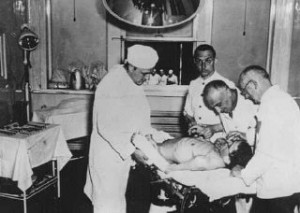In The Medical Profession as a Moral Community, Pellegrino discusses the two opposing moral orders that the medical profession faces: their ethical obligations to the sick and their obligation to self-interest and the marketplace. There is no resolution to the two conflicting orders, and those in the medical profession are usually forced to choose one or the other. Today, that is exactly what we see happen in the medical community today. Physicians are often conflicted with their moral obligation to treat, care, and give patients the best possible options and their obligation to their own personal interests. Pellegrino already provides us a couple examples in his essay of how physicians protect their own interests, such as taking part in physician sponsored corporations, unions or strikes or refusing to see poor, Medicare, Medicaid, or AIDS patients (pg. 224).
The American Medical Association (AMA) is one of the largest associations of physicians in the United States. According to the AMA website, its mission is “to promote the art and science of medicine and the betterment of public health.” The AMA website also provides a list of past and current physician ethics that it uses to set standards for medical education. Some examples from the AMA’s 2001 version of Principals of Medical Ethics include:
- “A physician shall be dedicated to providing competent medical care, with compassion and respect for human dignity and rights.
- A physician shall uphold the standards of professionalism, be honest in all professional interactions, and strive to report physicians deficient in character or competence, or engaging in fraud or deception, to appropriate entities.
- A physician shall respect the law and also recognize a responsibility to seek changes in those requirements which are contrary to the best interest of the patient.
- A physician shall support access to medical care for all people.”
As you can see, many of the AMA medical ethics serve to protect the physician as well as the patients. However, I find this set of AMA medical ethics rather ironic. Historically, the AMA has been known to oppose any legislation that does not benefit the physician even though it benefits other people, such as universal healthcare. Many times throughout our history, some form of universal healthcare has been proposed but it has been opposed by the AMA, physicians, and insurance companies. Rather than acting in the interest of patients, physicians and leaders of the AMA have acted in self-interest. This very concerning since the AMA has a lot of influence over physicians and the government. No longer is medicine a moral community, but it is a community that acts in the self-interest.
Pellegrino proposes that American health care system needs moral leadership and medical statesmanship, and I completely agree. Associations, like the AMA, insurance companies, and the government currently have a lot of power over our health care. However, their interests are power and money, which is not what medicine and health care should be about. I have heard stories about physicians go into medical school with a moral obligation to help the sick. However, once they finish, their priorities change. They get trapped into this system created by the AMA, insurance companies, and the government. While they are not morally “bad,” sometimes physicians are forced to refuse patients on Medicare or Medicaid because they need to pay off their medical debts or have an obligation to the hospital. I think if our generation of future physicians is able to stand together as a moral community, change is possible. If everyone is going into the profession with a moral obligation to help the sick, we might have very different leaders serving at these powerful organizations and perhaps medicine can truly be a moral community.
Citations:
Pellegrino, E. D. “The Medical Profession as a Moral Community.” Bulletin of the New York Academy of Medicine 66.3 (1990): 221-32. NCBI. Web. 20 Apr. 2014
http://www.ama-assn.org/ama/pub/about-ama/our-mission.page?





